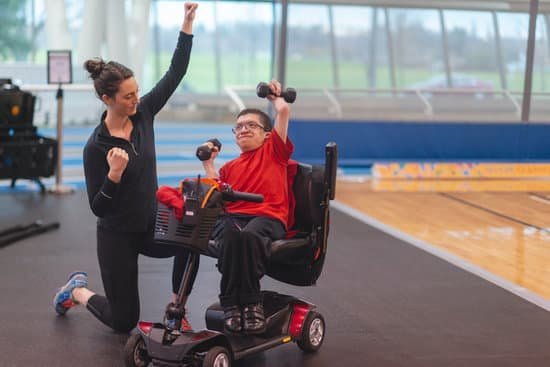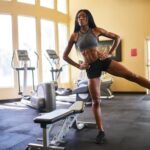As we age, staying fit becomes increasingly important for maintaining overall health and well-being. Finding the best exercises for staying fit after 50 is essential to ensure a fulfilling and active lifestyle in our golden years. Regular physical activity not only helps us stay in shape but also plays a crucial role in preventing chronic illnesses and enhancing our quality of life.
After reaching the age of 50, our bodies undergo various changes such as muscle loss, decreased bone density, and reduced flexibility. Engaging in appropriate exercises can help counteract these effects, allowing us to maintain strength, agility, and independence as we grow older. Whether you are new to exercise or have been active throughout your life, it’s never too late to start incorporating fitness routines tailored to your needs and goals.
In this article, we will explore the benefits of regular exercise after 50, ranging from cardiovascular workouts that keep our heart healthy to strength training that builds muscle mass and bone density. Additionally, we will delve into the importance of flexibility and balance exercises in preventing falls and improving mobility. By understanding the significance of staying physically active after 50 and implementing a well-rounded exercise routine, you can embark on a journey towards optimal health and vitality.
Benefits of Regular Exercise After 50
As we age, regular exercise becomes even more crucial for maintaining overall health and well-being. Engaging in the best exercises for staying fit after 50 can help improve cardiovascular health, strengthen muscles, enhance flexibility, and boost balance to prevent falls. The benefits of regular exercise after 50 are numerous and essential for living a long and healthy life.
Here are some key advantages of incorporating exercise into your routine after reaching the age of 50:
- Improved cardiovascular health: Cardiovascular exercises such as walking, swimming, or cycling can help reduce the risk of heart disease, lower blood pressure, and improve circulation.
- Increased muscle mass and bone density: Strength training exercises like weight lifting or bodyweight exercises can help build muscle mass and increase bone density, which is important for preventing osteoporosis.
- Enhanced flexibility and balance: Stretching exercises like yoga or tai chi can improve flexibility and balance, reducing the risk of injuries from falls.
Regular physical activity is also beneficial for mental health, as it can help reduce stress, anxiety, and depression. By making exercise a priority after 50, you can enjoy a better quality of life and maintain your independence as you age. Remember to consult with a healthcare provider before starting any new fitness program to ensure it’s safe for you based on your individual health needs.
Cardiovascular Exercises
Some of the best exercises for staying fit after 50 include walking, cycling, swimming, and aerobics. Walking is a low-impact exercise that can be easily incorporated into daily routines. Cycling is another excellent option for cardio exercise that is gentle on the joints. Swimming provides a full-body workout while being easy on the joints as well. Aerobics classes can offer a fun and social way to get your heart rate up and improve cardiovascular fitness.
Incorporating cardiovascular exercises into your routine at least three to five times a week for about 30 minutes each session can yield significant health benefits. It is important to start slowly and gradually increase the intensity and duration of your workouts to avoid injury.
Always listen to your body and consult with a healthcare provider before starting any new exercise regimen, especially if you have pre-existing health conditions. By staying consistent with your cardiovascular workouts, you can maintain a healthy heart and enjoy better overall health as you age gracefully.
Strength Training
When it comes to strength training after 50, it’s important to focus on exercises that target major muscle groups in the body. Some of the best strength training exercises for those over 50 include:
- Squats
- Lunges
- Push-ups
- Bicep curls
- Tricep dips
- Deadlifts
These exercises not only help build muscle but also promote better balance, coordination, and posture. It’s recommended to perform strength training exercises at least two to three times a week, allowing for rest days in between sessions to allow for muscle recovery and growth. Additionally, incorporating different variations of these exercises can help target different muscle groups and prevent plateaus in progress.
As with any exercise program, it’s essential to start slowly and gradually increase intensity as your strength improves. Always warm up before engaging in strength training activities and cool down afterwards to prevent injury. Remember that consistency is key when it comes to reaping the benefits of strength training after 50.
Flexibility and Balance Exercises
As we age, maintaining flexibility and balance becomes increasingly important to prevent falls and improve overall mobility. Flexibility exercises help to keep muscles and joints supple, while balance exercises work on stability and coordination. Incorporating these types of exercises into your fitness routine can significantly reduce the risk of injuries and enhance your quality of life.
Benefits of Flexibility Exercises
Flexibility exercises involve stretching various muscle groups to maintain or increase their range of motion. As we age, our muscles tend to become tighter, which can impact our overall flexibility. Regular stretching helps to counteract this by keeping muscles lengthened and improving joint movement. By incorporating flexibility exercises into your routine, you can enhance your posture, reduce stiffness, and even alleviate aches and pains commonly associated with aging.
Benefits of Balance Exercises
Balance exercises are essential for older adults as they help to improve stability, coordination, and proprioception (the ability to sense the position of your body in space). These exercises focus on strengthening the core muscles, lower body strength, and improving posture-all of which contribute to better balance control. By incorporating balance exercises into your fitness regimen, you can reduce the risk of falls, increase confidence in everyday movements, and maintain independence as you age.
Incorporating a combination of flexibility and balance exercises into your fitness routine is crucial for staying fit after 50. Consider activities such as yoga, Pilates, tai chi, or simple stretches that target different muscle groups.
Remember to start slowly and gradually increase the intensity as you build strength and stability. Prioritizing these types of exercises along with cardiovascular workouts and strength training will help you achieve a well-rounded fitness program that supports overall health and vitality in your golden years.
Recommended Exercise Routine for Those Over 50
As we age, it becomes increasingly important to maintain a regular exercise routine to ensure our overall health and well-being. Engaging in the best exercises for staying fit after 50 can help not only improve physical fitness but also boost mental health and reduce the risk of chronic diseases. Finding a balanced exercise routine that includes cardiovascular, strength training, flexibility, and balance exercises is key for those over 50 looking to stay active and healthy.
Cardiovascular Exercises
Cardiovascular exercises are crucial for keeping the heart healthy and strong, especially as we age. Activities like brisk walking, swimming, cycling, or aerobic classes can help improve cardiovascular endurance, lower blood pressure, and reduce the risk of heart disease. Aim for at least 150 minutes of moderate-intensity cardio exercise per week spread out over several days to maximize the benefits on your heart health.
Strength Training
Strength training is essential for building muscle mass and bone density, which tend to decrease as we age. Lifting weights or using resistance bands can help strengthen muscles, increase metabolism, and improve overall functional strength. Aim to include strength training exercises at least two to three times a week, focusing on major muscle groups like legs, back, chest, arms, and core. Start with lighter weights or resistance bands and gradually increase as you get stronger.
Flexibility and Balance Exercises
Flexibility and balance exercises are important for preventing falls and improving mobility as we age. Activities like yoga, tai chi, or simple stretching routines can help maintain flexibility in joints and improve balance to reduce the risk of injuries.
Incorporate flexibility exercises into your routine at least two to three times a week to enhance mobility and joint range of motion while also helping prevent stiffness. Additionally, practice balance exercises like standing on one foot or heel-to-toe walking regularly to improve stability and coordination.
Tips for Getting Started With a Fitness Program After 50
As you embark on your fitness journey after the age of 50, it’s important to acknowledge and overcome common challenges that may arise. One of the key obstacles that many face is finding the motivation to start and stick to a fitness program.
It can be daunting to begin something new, especially if you haven’t been active for a while. However, remember that consistency is key, and even small steps towards your fitness goals can make a significant difference in your overall health.
Another challenge that individuals over 50 may encounter is dealing with pre-existing health conditions or physical limitations. It’s crucial to consult with your healthcare provider before starting any exercise routine to ensure that it is safe and appropriate for you. They can provide valuable insights on modifications you may need to make based on your individual circumstances, allowing you to exercise effectively while minimizing the risk of injury.
Additionally, adjusting your mindset and setting realistic goals are essential components of overcoming challenges when starting a fitness program after 50. Understand that progress may be gradual, and it’s okay to start at a lower intensity level before gradually increasing as your fitness improves. Celebrate each milestone along the way and don’t compare yourself to others – focus on your own journey towards better health and well-being.
| Common Challenges | Strategies for Overcoming Them |
|---|---|
| Lack of motivation | Set achievable goals, find an exercise buddy, vary your routine |
| Pre-existing health conditions | Consult with healthcare provider, tailor exercises to suit your needs |
| Setting unrealistic goals | Start slow, celebrate small victories, focus on personal progress |
Importance of Proper Nutrition and Hydration for Maintaining Fitness After 50
Proper nutrition and hydration play a crucial role in maintaining fitness after the age of 50. As our bodies age, it becomes even more essential to fuel ourselves with the right nutrients and stay adequately hydrated to support overall health and physical performance. Nutrient-rich foods provide the necessary energy for workouts, aid in muscle recovery, and help to maintain a healthy weight.
For individuals over 50, focusing on a balanced diet rich in fruits, vegetables, whole grains, lean proteins, and healthy fats is key. These foods can provide essential vitamins and minerals that support bone health, muscle function, and overall well-being. Adequate protein intake is particularly important for maintaining muscle mass as we age, which can help to prevent loss of strength and mobility.
In addition to proper nutrition, staying properly hydrated is crucial for optimal performance during exercise, especially as we age. Dehydration can lead to decreased energy levels, muscle cramps, and impaired cognitive function.
It’s recommended for older adults to drink water regularly throughout the day and also consider consuming electrolyte-rich beverages if engaging in prolonged or intense physical activity. By combining a nutritious diet with adequate hydration practices, individuals over 50 can maximize the benefits of their exercise routine and support their long-term health goals.
How to Monitor Progress and Stay Motivated While Exercising After 50
As individuals age, it becomes increasingly important to prioritize their physical fitness and overall health. Engaging in regular exercise after the age of 50 offers numerous benefits that can help maintain a high quality of life and independence. From cardiovascular exercises to strength training and flexibility routines, there are a variety of workouts that cater specifically to the needs of older adults.
Cardiovascular exercises, such as walking, cycling, or swimming, help keep the heart healthy and strong. Regular aerobic activity can improve circulation, reduce the risk of heart disease, and boost overall energy levels. Strength training is also crucial for building muscle mass and bone density, which can prevent osteoporosis and preserve mobility. Combining both cardio and strength exercises into one’s routine is essential for optimal health after reaching the age of 50.
In order to stay motivated and monitor progress while exercising after 50, setting realistic goals is key. Tracking your workouts, measuring improvements in strength or endurance, and celebrating milestones along the way can help maintain motivation levels.
Additionally, finding a workout buddy or joining group fitness classes can provide a sense of accountability and make exercise more enjoyable. With dedication and consistency in following a well-rounded fitness plan tailored for those over 50, individuals can continue to lead active and fulfilling lives well into their golden years.
Frequently Asked Questions
What Is the Best Exercise to Stay Fit After 50?
Staying fit after 50 involves a combination of different types of exercises, but one of the best ones is strength training. This helps maintain muscle mass, bone density, and metabolism, all of which tend to decline with age.
Can You Reshape Your Body at 50?
While it may be more challenging to reshape your body at 50 compared to when you were younger, it is definitely possible with dedication and consistency. Focus on a balanced diet, regular exercise, getting enough rest, and staying hydrated to achieve your fitness goals.
How Do I Get in the Best Shape of My Life After 50?
Getting in the best shape of your life after 50 requires a holistic approach that includes both exercise and nutrition. Incorporating strength training, cardiovascular exercises, flexibility workouts, and proper recovery techniques can help you improve your overall fitness level as you age.
Making healthy food choices and staying consistent with your workout routine are key factors in achieving optimal physical fitness after 50.

Passionate about providing useful information to anyone with an interest in the field of Personal Training, I strive to pass on to our readers quality information and to answer any questions about Personal Trainers, the work they do and how to become one.





